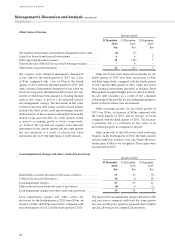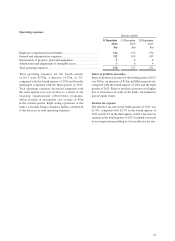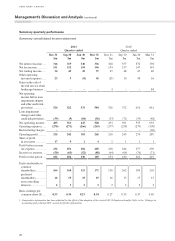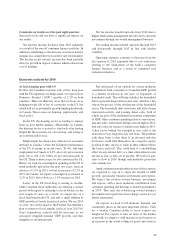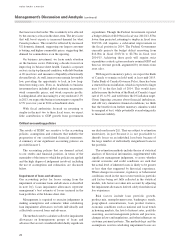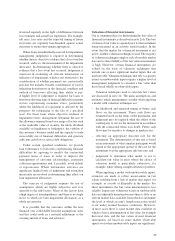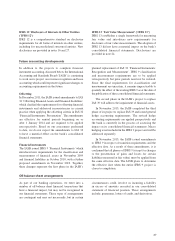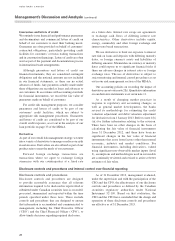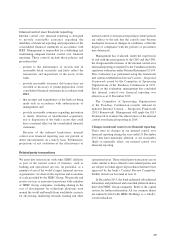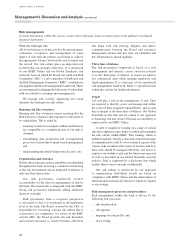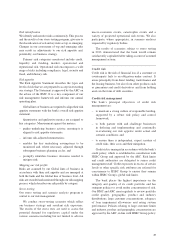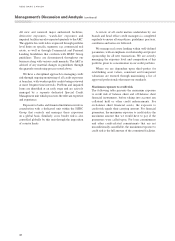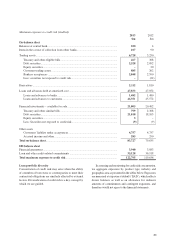HSBC 2013 Annual Report Download - page 32
Download and view the complete annual report
Please find page 32 of the 2013 HSBC annual report below. You can navigate through the pages in the report by either clicking on the pages listed below, or by using the keyword search tool below to find specific information within the annual report.
Risk management
(Certain information within this section, except where indicated, forms an integral part of the audited consolidated
financial statements)
How we manage risk
All of our business activities involve the measurement,
evaluation, acceptance and management of some
degree of risk with the primary goal being to achieve
the appropriate balance between the risk assumed and
the reward. Our risk culture plays an important role
in delivering our strategic objectives. It is reinforced
by our HSBC Values and our Global Standards, and
forms the basis on which the Board, the Audit and Risk
Committee (‘ARC’), a sub-committee of the Board, and
the Risk Management Committee (‘RMC’) establish our
risk appetite and the risk management framework. These
are instrumental in aligning the behaviour of individuals
with our attitude to assuming and managing risk.
We manage risk actively, employing five main
elements that underpin our risk culture.
Running risk like a business
Running risk like a business means ensuring that the
Risk function is dynamic and responsive to the needs of
its stakeholders. This is aided by:
– ensuring systems (for example, in Risk and Finance)
are compatible so a complete picture of our risks is
obtained;
– streamlining data production and re-engineering
processes to create time to spend on risk management;
and
– understanding the detail behind our risks and costs.
Organization and structure
Robust risk governance and accountability are embedded
throughout the bank, fostering a continuous monitoring
of the risk environment and an integrated evaluation of
risks and their interactions.
Our risk governance framework ensures
accountability for the effective management of risk by
the bank. The framework is integrated with the HSBC
Group risk governance framework adding additional
layers of oversight.
Risk governance from a corporate perspective
is structured so that it is positioned at the uppermost
level of the bank. The Board, assisted by the ARC, is
responsible for overseeing a strong risk culture that is
conservative yet competitive. On advice of the RMC
and the ARC, the Board provides the risk discipline
and structure necessary to achieve business objectives
that align with risk strategy. Regular and timely
communication between the Board and executive
management ensures that key risks are identified and
key information is shared regularly.
Three lines of defense
The risk governance framework is based on a risk
management and internal control structure referred
to as the ‘three lines of defence’ to ensure we achieve
our commercial aims while meeting regulatory and
legal requirements. It is a key part of our operational
risk management framework. Refer to operational risk
within this section for further information.
People
All staff play a role in the management of risk. They
are required to identify, assess and manage risk within
the scope of their assigned responsibilities, and as such
they form part of the three lines of defence. Our Global
Standards set the tone and are central to our approach
to balancing risk and reward. Personal accountability is
reinforced by our HSBC Values.
A suite of mandatory training on a range of critical
risk and compliance topics helps to embed and strengthen
the risk culture within HSBC. This training, which is
updated regularly, ensures a clear and consistent message
is communicated to staff. It covers technical aspects of the
various risks assumed in the course of business and how
these risks should be managed effectively, and serves to
reinforce our attitude to risk and the behaviours expected
of staff as described in our Global Standards and risk
policies. Staff is supported by a disclosure line which
enables them to raise concerns confidentially.
Our risk culture is reinforced by our approach
to remuneration. Individual awards are based on
compliance with HSBC Values and the achievement of
financial and non-financial objectives which are aligned
to our strategy.
Risk management processes and procedures
Risk management within the bank is driven by the
following four processes:
– risk identification;
– risk appetite;
– mapping our risk profile; and
– stress testing.
HSBC BANK CANADA
Management’s Discussion and Analysis (continued)
30


